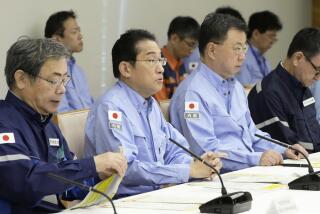USGS dubs Japan earthquake ‘Tohoku’
U.S. Geological Survey officials have chosen a name for the 9.0 temblor that struck Japan last week. They’re calling it the Tohoku earthquake — shortened from the original name used in Japan.
Tohoku is a region in the northern part of Honshu, Japan’s largest island. Though the region — encompassing six of the island’s northernmost prefectures — sits north of the massive quake’s offshore epicenter, it became its namesake because it takes up much of the area shaken by the earthquake’s approximately 250-mile-long rupture area.
The name comes from the Japanese words “Tohoku-Chiho Taiheiyo-Oki,” said Brian Atwater, a geologist with USGS. Roughly translated, this means, “Pacific offshore Tohoku region.”
Photos: Earthquake and nuclear crisis in Japan
Officials decided that “Tohoku” was the key phrase in the name.
“We could have used ‘Northern Japan,’ but that would have included Hokkaido,” Atwater said. Hokkaido is the Japanese island just north of Honshu; its southern tip barely touches the rupture area.
Naming the earthquake after a point closer to the epicenter did not make sense either, Atwater said. In earthquakes such this one, the epicenter doesn’t matter as much the areas affected.
“The point can be likened to a match in a house fire — the source for the heat, as it were,” Atwater said. And fires, he pointed out, fires are named after the places they burn, not the matches that light them.
More to Read
Sign up for Essential California
The most important California stories and recommendations in your inbox every morning.
You may occasionally receive promotional content from the Los Angeles Times.











